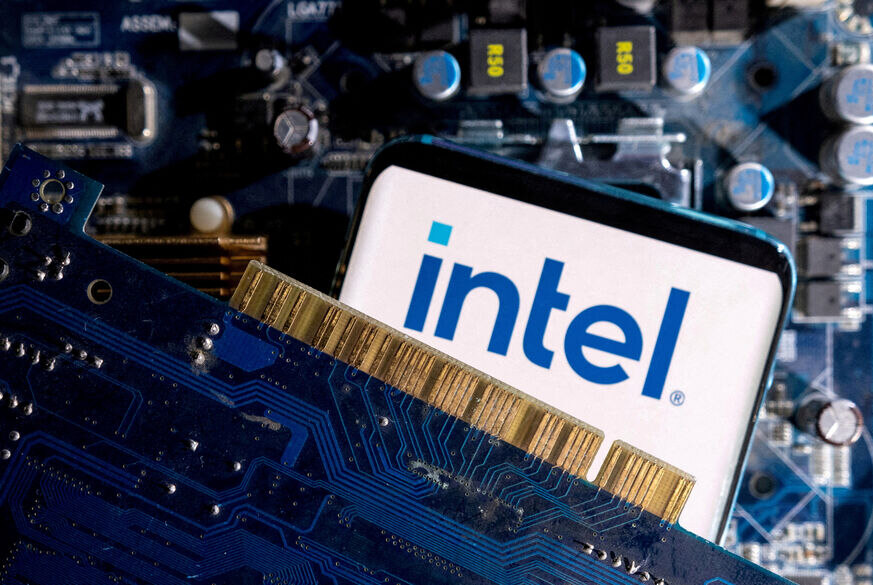Intel Continues to See Revenue Declines. Can the Stock Rebound?


Intel's (NASDAQ: INTC) fourth-quarter results topped analysts' expectations but also showed a company that continues to struggle to find its footing. Its revenues once again declined, and it delayed an important chip launch. The stock is down more than 50% over the past year.
Let's take a closer look at the semiconductor company's Q4 results, and whether it can pull off a turnaround.
Revenue declines and foundry losses
For the third consecutive quarter, Intel saw its revenue decline. For Q4, revenue dropped 7% year over year to $14.3 billion while adjusted earnings per share (EPS) plunged 76% to $0.13.
Nonetheless, the results topped the analyst consensus calling for adjusted EPS of $0.12 on revenue of $13.8 billion.
Gross margin, meanwhile, fell by 650 basis points from 45.7% to 39.2%.
Intel's product segment saw revenue fall 6% to $13 billion. Within the segment, the client computing group's revenue declined by 9% to $8 billion. This unit is home to Intel's core personal computer CPU (central processing unit) business. It said it is on track to ship 100 million cumulative artificial intelligence (AI) PCs by the end of 2025, and that it will launch its new Panther Lake chip in the second half.
Intel's data center and AI unit, meanwhile, saw sales decline 3% to $3.4 billion, while its network and edge unit saw sales decline by 10% to $1.6 billion. The company is working on closing competitive gaps within the data center and has a number of upcoming data center CPU launches over the next two years to help in that regard. However, it is pushing back the expected launch of its important Clearwater Forest data center processor to the first half of 2026.
Overall, operating income for Intel's product segment fell 18% to $3.6 billion. Nearly $3.1 billion of that comes from CCG, which saw its operating income drop by 14%.
Intel's foundry segment, meanwhile, continued to struggle. Foundry revenue fell by 13% to $4.5 billion. The segment's operating loss expanded from $1.3 billion to $2.3 billion. It is looking to be breakeven in this segment by the end of 2027, helped by improved efficiencies and internal and EUV (extreme ultraviolet) wafers.
Client Computing | Data center | Network and edge | Product segment | Foundry segment | |
|---|---|---|---|---|---|
Revenue | $8 billion | $3.4 billion | $1.6 billion | $13 billion | $4.5 billion |
Revenue Growth | -9% | -3% | -10% | -6% | -13% |
The company generated $8.3 billion in operating cash flow during 2024, but it spent $23.9 billion in capital expenditures (capex) as it continues to build out its foundry operations. It ended the year with $50 billion in debt against $22.1 billion in cash and short-term investments. It also has $7.86 billion in grants from the U.S. Department of Commerce to build out its foundries in the U.S.
Looking ahead, Intel forecast first-quarter revenue to be between $11.7 billion and $12.7 billion, compared to revenue of $12.7 billion a year ago. It's looking for 36% gross margin, down 910 basis points year over year, and adjusted EPS of $0.00, compared to $0.18 last year. It plans to lower its 2025 capex to around $20 billion.
Intel plans to focus on monetizing non-core assets to help pay down debt. This includes selling a stake in Altera and potentially IPOing the unit down the road.

Image source: Getty Images.
Can Intel's stock rebound?
Intel continues to be challenged. It still has a solid position in PCs, but it's struggled to make bigger inroads in the fast-growing data center market. The delay of its Clearwater Forest CPUs for data centers, which use its new 18A technology, is a big disappointment. This likely pushes back the chance of the company regaining data center CPU market share until at least next year. Meanwhile, the delay likely helps rival Advanced Micro Devices (NASDAQ: AMD), which has been taking share in data center CPUs.
Intel's foundry business remains a drag, as it continues to rack up losses and drain cash flow due to its heavy capex costs. However, these are real assets it is buying, and the unit is a hidden value within the company.
Turning to valuation, Intel trades at a forward price-to-earnings ratio (P/E) of 16 based on 2025 analyst estimates. However, its foundry losses obscure the lower valuation of Intel's underlying core business. In 2024, Intel's product segment generated $13.1 billion in operating income, which would equate to EPS of about $2.27 (assuming a 25% tax rate and 4.33 billion shares). As such, its core business is trading at about 8.6 times 2024 core EPS.
Meanwhile, in just the last three years, it has spent $74.5 billion in capex, mostly on its Foundry unit. If you subtract Intel's net debt from that, this unit can be valued at $10.50 per Intel share based on the value of its physical assets minus debt. Its stakes in Mobileye and Altera also have some value.
Thus, while Intel continues to have its fair share of struggles, I do think there's still some good hidden value with its share price at current levels that it may be able to unlock in the near future.







